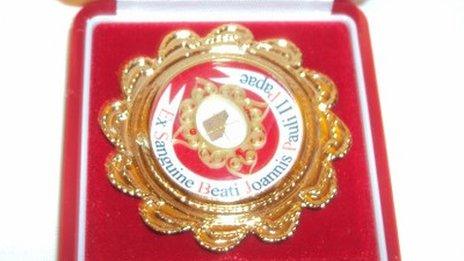Saint's bone, found in rubbish, returned to Catholic Church
- Published
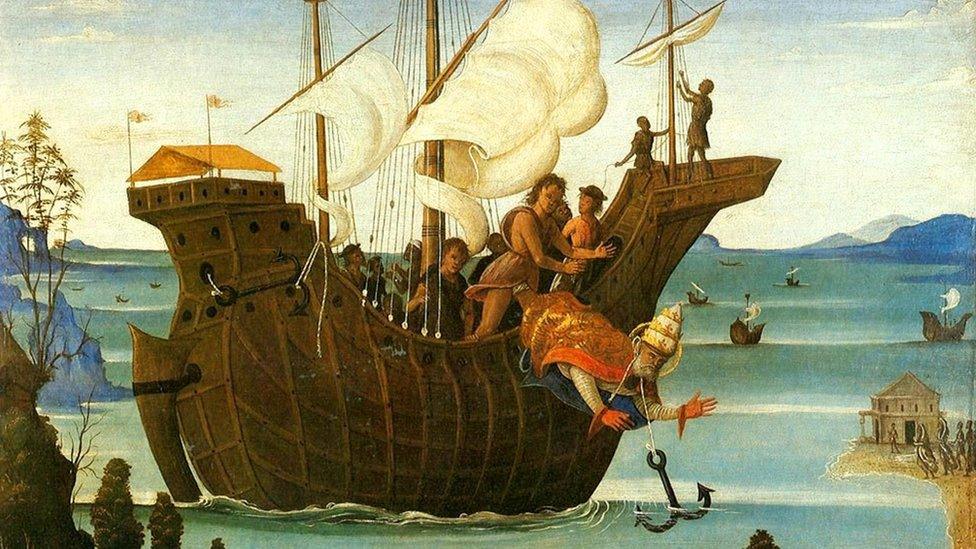
The Martyrdom of St Clement by Bernardino Fungai, about 1500
A drama that spans a continent and 2,000 years, includes the execution of a Pope by drowning and a central London car break-in, has culminated in a ceremony at Westminster Cathedral.
A case, containing a fragment of bone, purported to belong to St Clement who was ordained by St Peter and was Pope in the early years of the Christian Church, has been presented to the cathedral in a formal ceremony.
Some time after it was stolen from its owner's car, it turned up in a rubbish haul from house and office clearances.
It fell to James Rubin, owner of Enviro Waste, to hand the relic over to Archbishop George Stack, representing the Catholic Church in England and Wales.
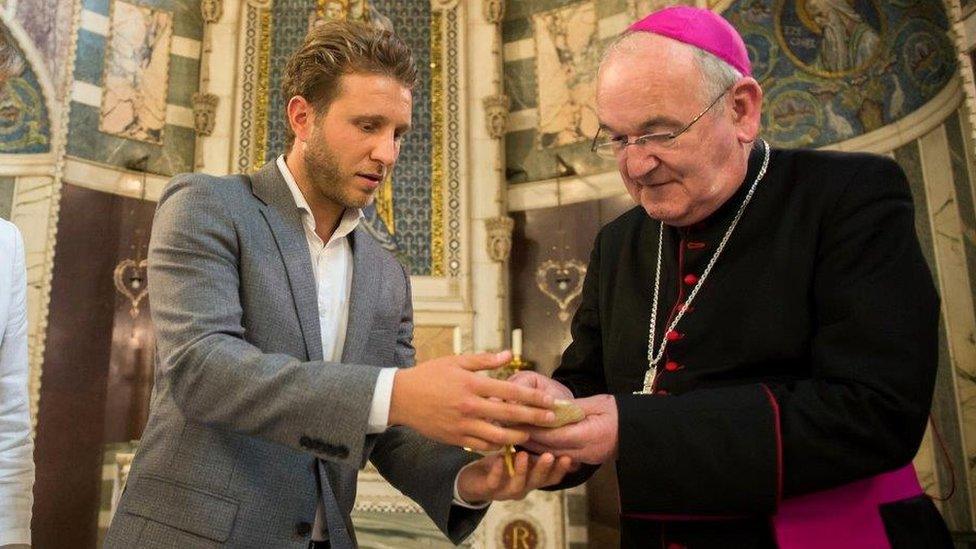
James Rubin presented the relic to Archbishop George Stack
Where has this come from?
In February last year Mr Rubin spotted the unusual-looking object on a desk in the company's warehouse in Leyton, east London, where staff had been sorting waste to see what could be recycled or refurbished.
He asked: "Where has this come from?" but no one knew.
He says it's very hard to pinpoint exactly where it was found as the company's trucks clear up to 30 premises a day.

Mr Rubin spotted the relic on a desk in his company's warehouse
He took it back to his office and hit Google.
"It's got Latin on the front. It says 'EX OSS ST CLEMENTIS' and that's what gave me the idea that it was from the bone of a saint."
He thought of giving it to a museum or university hoping they would be able to work out "if it was what we thought it was".
"I really didn't know what to do with it."
So Mr Rubin appealed to the public for suggestions on the firm's blog., external
There were hundreds of messages, including from institutions as far away as Hungary and the United States, keen to take the relic.
But Westminster Cathedral also responded and he decided it should go there.
"It just felt like the right thing to do."
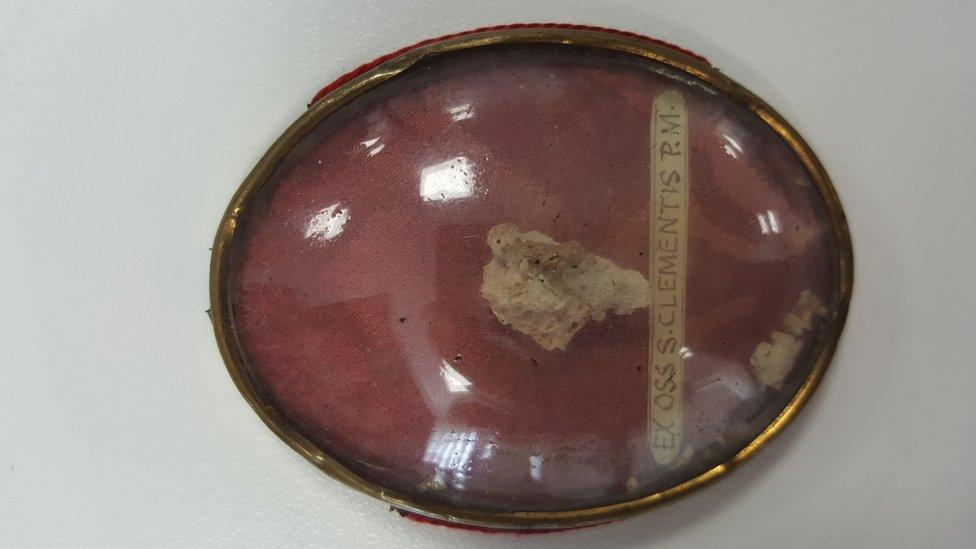
James Rubin deciphered the Latin inscription on the case
The relic's owner - who has decided to remain anonymous - came forward, saying it had been stolen during a car break-in, but agreed it should go to the cathedral on permanent loan as part of its Treasures Exhibition. , external
"It's a really happy outcome to this particular extraordinary story," says historian and Catholic cultural expert Sophie Andreae, who brokered the deal for the cathedral.
"These objects are of very great significance. Catholics feel that they have not just a link with a very holy person from the past, but also a link with the divine."
What of its deeper past?
St Clement was Pope for just over a decade until the Emperor Trajan ordered him to be banished and then executed in about AD100.
Legend has it that he was thrown off a boat off the coast of what is now Crimea, tied to an anchor.

An 11th Century fresco inside Basilica San Clemente shows the bones arriving in Rome
He is recognised as a saint by both the Catholic and Orthodox Churches and because of his watery martyrdom is also the patron saint of mariners.
The story goes that a miraculous ebbing of the sea revealed a shrine containing his bones.
Almost 800 years later some of the bones are said to have been brought to Rome and enshrined in the Basilica di San Clemente.
A monastery in Ukraine is said to have his head and other relics.
So is this fragment really from one of his bones?
"How can we be sure?" says Dr Tessa Murdoch, Deputy Keeper of Sculpture, Metalwork, Ceramics and Glass at London's Victoria & Albert Museum
"It purports to be and it has been treasured as that."
She says the inscription on the red wax seal on the case which includes a cardinal's hat and tassels could give clues about when the relic was endorsed by the Catholic Church.
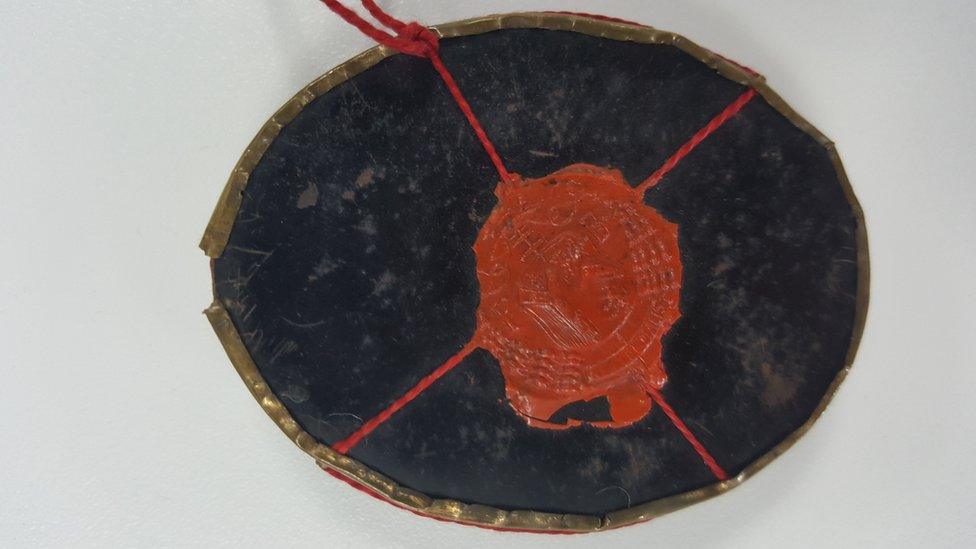
The seal on the back of the case could give clues as to the date it was authorised by the Church
Dr Murdoch says altars in early Christian churches would have relics placed inside them to enhance their sacred properties.
"A part of a relic was representative of the whole. So even though this is a tiny piece, purporting to be the bone of St Clement, it represents the whole saint and martyr.
"Because these things are cherished and kept in sacred places and sacred spaces, sometimes under altars, the general public is not perhaps aware of their potency and so it's very rare that something like this comes into the public domain in such extraordinary circumstances, and it kind of reminds us all of the extraordinary power and association of such a small object."
She says the best way to comprehend their significance is to think of gifts between loved ones, for example locks of hair.
"We can relate to things like that but if you actually translate those sort of special gifts between loved ones into the life of faith and sacred gifts, I think it helps understand the depth of power that these objects have."
How did it come to the UK?
"We can't possibly know," says Ms Andreae.
She points out that in the 16th Century under Henry VIII, the reformation saw huge destruction of relics in England, with the tombs of saints "completely smashed up".
Some Catholics were able to hide sacred objects in their homes but, more probably, Ms Andreae believes, this relic was brought to England in the early 19th Century once persecution eased and wealthier Catholics could travel abroad, some bringing artefacts from Italy back with them.
Mr Rubin says the find trumps all the other strange objects his firm has retrieved over the years, from personal financial details, stuffed pets and even someone's OBE medal.
"It's amazing. Crazy," he says.
- Published1 February 2018
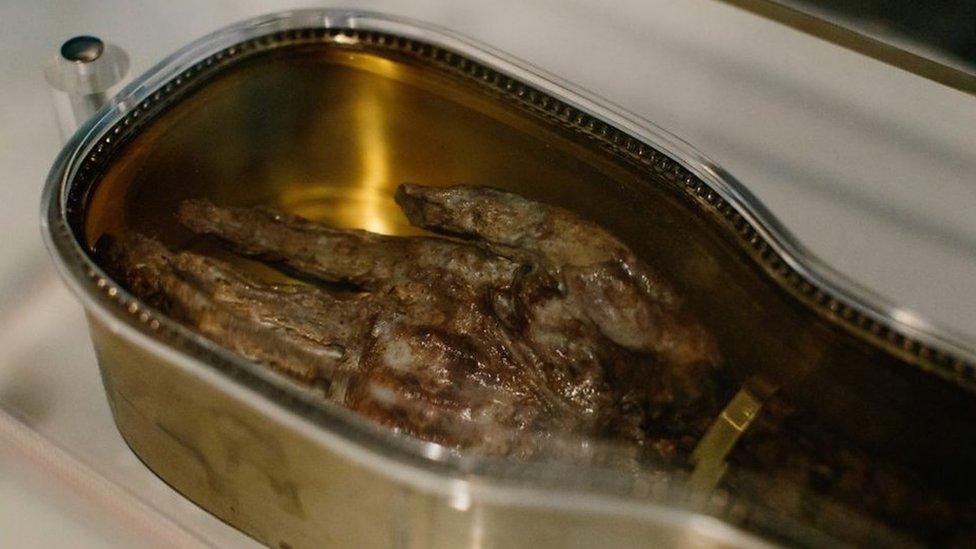
- Published30 January 2014
